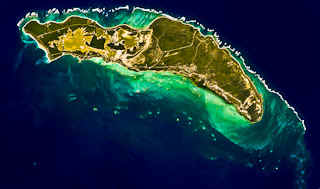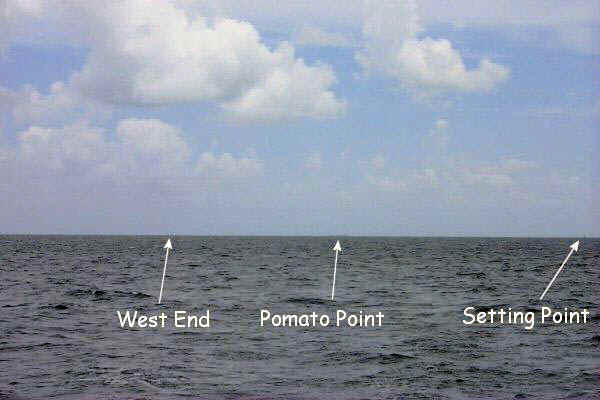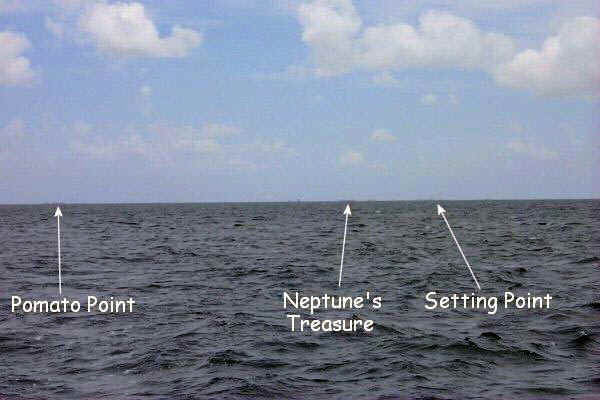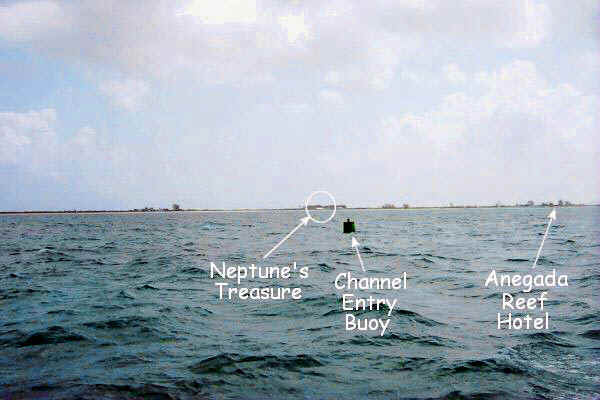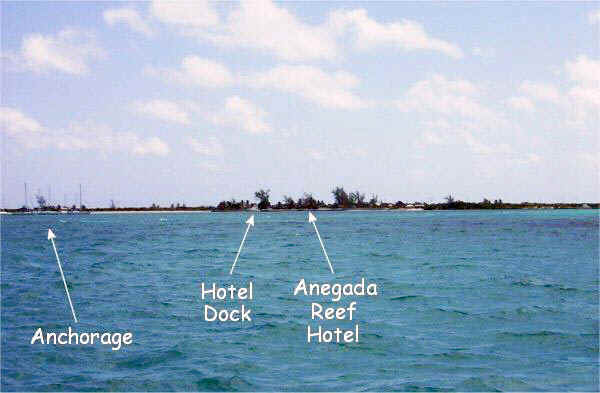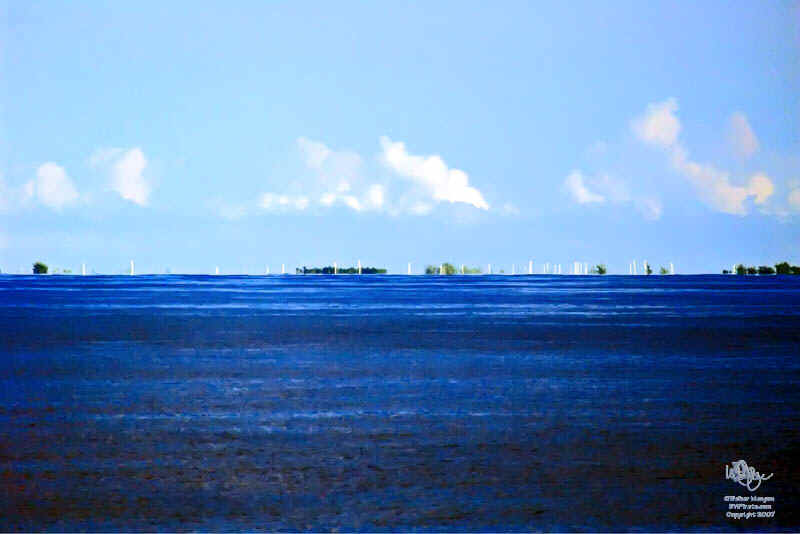- Select the main menu.
- Select Map Setup.
- Select Map Information (you may have to press the MENU button again).
- Select the BlueChart entry and press ENTER.
- Scroll to each of the charts Im1(a), Ima, Ima1(A), Ima2(A), Ima23(A), Ru21085 then move the cursor over the checkbox to the left of the chart and press ENTER. Doing this should remove the check mark from the box, indicating that the chart has been disabled.
- When you press the QUIT or ESC button to go back up one menu level, you will see that the check mark in the box for the entire chart set is now removed. This does not mean that the entire chart set is disabled. It only means that one or more charts within the set is disabled. Selecting this box and pressing the ENTER button twice will re-enable all of the charts in the set, indicated by the check mark being in the box.
![]()
Where it's all about the fine art of doing
absolutely nothing.
In good weather, navigating to Anegada safely is very easy if you know the landmarks on the island. This page will show you those landmarks and describe in detail how to safely get to Anegada. Keep in mind that Anegada is surrounded by submerged coral heads, and should only be approached in good weather conditions with the sun overhead so that you can clearly see the bottom. Judge your departure time accordingly. A tip from Walker: if you are planning on being at Anegada for more than a day or two, make sure you have ample fresh water aboard. There is no fresh water available at Anegada, and it's a long way back to the nearest source, which would be Leverick Bay (13 nm) or Marina Cay (17 nm).
A highly detailed chart of the
approach to Anegada is available for free download here. This chart is a must for sailors that want to visit Anegada
safely. It accurately depicts the approach to the anchorages at the western end of
Anegada, including the Anegada Reef Hotel anchorage, Neptune's Treasure, and the Pomato
Point anchorage. The shaded depth contours on the chart are in 2 foot intervals.
Anegada is surrounded by dangerous reefs that have claimed over 150 vessels. Boats still
go aground on the Anegada Reef very often. If you are sailing to Anegada, then using our
chart along with the instructions on this web page will make your trip safe and enjoyable.
Note: All other printed charts and GPS data for this area are derived from surveys made
over 150 years ago. Most other sources have incorrect depictions of the Anegada entrance
and no detailed depth information. Groundings and serious injuries have occurred in recent
years while navigating the Anegada entrance with up-to-date (but incorrect) electronic
charts. Our chart is made from extensive surveys performed by us in 2004 and is the only
recent charting of the water near Anegada. It is the only chart in existence that shows
detailed sea bottom information for the Anegada anchorage areas.
Having GPS is definitely not a requirement for navigating to Anegada. However, many boats now have GPS and many sailors (myself included) have handheld GPS units. I say, if ya got it, use it. Besides, GPS makes the trip more interesting. Therefore, I have included GPS coordinates for the Anegada channel, as well as for various starting locations for the trip to Anegada. These are WGS-84 coordinates that I have personally recorded and verified. Note: If you have a Garmin GPS and Garmin BlueChart electronic charts, see the important notice below.
I find that the best time to arrive at Anegada is around 10 or 11 AM, as those that are leaving the anchorage have typically departed by then, leaving the best locations in the anchorage available for my arrival. Also, if you are unfamiliar or uneasy with the approach and are arriving around this time, you can "cheat" on finding the channel by watching the departing boats as they head west and then turn south at the channel entrance. Just pass the parade of departing boats, making sure that at least some of them are to the east of you!
Click here to view a chart from Camanoe/Virgin Gorda to Anegada.
First, the basics: the GPS coordinates for the center of the entrance to the Anegada channel N18 42.811 W64 23.668. If you are using GPS and starting from the Virgin Gorda area, the rhumb line to the channel entrance will take you fairly close to some serious shoals and coral, especially if you stray off course to the east. Therefore, I would suggest that you not set your course directly for the entrance, but rather to the intermediate waypoint N18 42.100 W64 24.200, which is about a mile SSW of the entrance. This only adds about a quarter of a mile to the total trip, and should keep you clear of all coral.
If you are entering a route into your GPS, then use the following waypoints for the Anegada channel. This route is shown as the yellow line on the Anegada Approach chart mentioned above.
Waypoint |
GPS Coordinates |
|---|---|
Approach waypoint |
N18 42.100 W64 24.200 |
| Channel entrance | N18 42.810 W64 23.661 |
| Intermediate channel waypoint | N18 43.015 W64 23.230 |
| Channel end | N18 43.060 W64 23.040 |
Starting from various locations, the course and distance to the outer buoys of the Anegada anchorage entrance channel are:
Starting Location |
GPS Coordinates |
Bearing (True) |
Bearing (Magnetic) |
Distance (NM) |
|---|---|---|---|---|
| Colquhoun Reef | N18 30.871 W64 22.909 | 356° | 009° | 12.0 |
| Mountain Point, Virgin Gorda | N18 30.250 W64 25.100 | 006° | 019° | 12.5 |
| The Dogs | N18 29.576 W64 27.700 | 016° | 029° | 13.5 |
| East End of Scrub Island | N18 28.210 W64 30.000 | 022° | 035° | 15.8 |
| Camanoe passage between Great Camanoe and Scrub Island | N18 28.099 W64 31.562 | 026° | 039° | 16.5 |
(Magnetic bearings calculated with 13° west magnetic variation) |
||||
There is usually about 1 knot or so of current that will set you down to the west. The current is much stronger as it comes through the Necker Island Passage on the southern end of the trip, when you are just leaving the North Sound or Camanoe. In the early part of the sail to Anegada, the current can run as much as two knots. Once you are abeam of Horseshoe reef, the current eases off a bit. Therefore, it is especially important to make allowance for the current in the early part of the sail, lest you wind up beating or motoring into Anegada. Also, the wind is normally an easterly, which will result in leeway to the west. So for any of these starting locations, you should steer a bit to the east to counter the current and your leeway. The typical correction for a sailboat making good 7 or 8 knots is to steer about 8 to 10 degrees to the east of the magnetic course. Don't overdo it, however, as there is coral to the east of the approach, while there is open water to the west. If you have to be wrong, be wrong to the west. If you are sailing from the Virgin Gorda area, be especially careful not to get to the east of the rhumb line. If you pay attention, you should arrive right on target.
As you depart, leaving the other islands in your wake, you will not be able to see Anegada until you are about 6 or so miles out if the air is clear and dry. If it is hazy or the visibility is poor, don't expect to see Anegada quite so soon. A good pair of binoculars will help here. If you have steady hands and the seas are not very rough, you will be able to pick Anegada up with binoculars from a good distance. With the naked eye, you should be able to spot the island from 4 to 6 miles out.
In contrast to the rest of the British Virgin Islands, Anegada is a a low coral atoll, 28 feet above sea level at its highest point. Indeed, the trees on Anegada more than double the height of the island. The tops of the trees are the first things that you will see when approaching the island.
Note: You can click on any of the photos below to view it as a large high-resolution image.
The first photo shows what you should see when you first spot Anegada:
At this point, you should head for the large group of trees which marks Pomato Point. The current and your leeway will set you to the west, which is a good thing. You do not want to get east of Pomato Point until you have positively identified the channel entrance.
As you get nearer, you will be able to make out the stand of palm trees at Neptune's Treasure. These trees are identifiable in the photo below. They are easy to identify because they have a very uniform flat-topped appearance. The rest of the trees that are visible are Australian Pines, and have a very irregular appearance.
The entrance to the channel is less than a mile off the beach, between Pomato Point and Setting Point. As you get closer, a white roof will appear in the middle of the palm trees. This is Neptune's Treasure Restaurant. When you have positively identified the white roof, sail directly toward it if you are coming from the Scrub Island area. If you are coming from Virgin Gorda, continue to sail toward Pomato Point -- this should take you within easy sighting distance of the outer channel markers while keeping you clear of the reef.
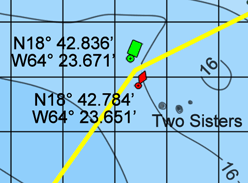 |
Snippet from Anegada Approach Chart showing the Two Sisters. |
There is a large reef called "Prawny Shoal" with exposed coral to the south of Anegada, about half a mile to the east of your course, and about a mile and a half off the beach. If the seas are running from the east or southeast, you should see large breaking waves on the reef. To the east of the rhumb line, there are also smaller bits of coral which rise abruptly and reach to just below the surface that are invisible until you are within only a short distance from them. There is a group of coral heads known locally as the "Two Sisters" that rise to within a few feet of the surface only 300 feet southeast of the red entrance buoy. Therefore, careful navigation to the entrance channel is a must.
During most of the crossing, you will be in water that is 60 feet or deeper, and is dark blue in color. As you near Anegada, the water will become shallower, and will noticeably lighten in color as the sandy bottom becomes visible. Occasionally look down as you sail -- you will be able to see nice bottom detail as the water begins to shallow. Do NOT venture into water less than 20 feet deep until you have positively identified the outer channel entry buoy(s)! This should keep you well clear of any coral. Speaking of colors, you might notice that the bottom of the clouds over the Anegada flats appear to have a bit of a greenish tint to them from the reflected light below. This effect is very pronounced if you are wearing polarized sunglasses.
The outer markers at the entrance to the channel are a green buoy and a red buoy. The markers are not very large, and you will not be able to see them until you are fairly close -- especially if the seas are rough. The channel entry is actually not very far from the beach -- only about 0.6 nm from Pomato Point. From the entrance, Setting Point bears approximately 060° magnetic. If you sail so that the bearing to Setting Point is more than 065° magnetic and you have not spotted the channel, then you are probably too far to the west and are sailing up the west end of the island beyond Pomato Point. This is a very common mistake. If this happens, turn around and head back due south until Setting Point bears 060° magnetic, then steer straight for Setting Point and look for the channel markers. Remember, they are between Pomato Point and Neptune's Treasure. You should also probably douse your sails and start the engine, as you will probably be too close to the wind for sailing in. Do not attempt to directly approach the entrance channel if you are north of Pomato Point. Click here for my personal eye-witness account of watching someone do this. If you cannot find the channel markers, call the Anegada Reef Hotel on VHF channel 16 and ask for assistance.
The photo below was taken at the Anegada channel entrance. The red buoy is just to the right, off the edge of this photo. It is important to identify the channel entrance buoys and pass between them! You can clearly see the white roof of Neptune's Treasure in the palm trees behind the channel entry buoy.
You should be prepared to douse your sails before entering the channel and motor in from the entrance, as the wind will most likely be far enough forward that you will not be able to sail straight up the channel. Pass directly between the entrance buoys and turn to starboard. The compass heading up the channel from the entrance is 080° magnetic. There are two more red buoys further up the channel. Pass within a few boatlengths of these buoys, leaving them to starboard.
If you are unfamiliar with the water here, you may be spooked by the very dark patches on the bottom. If the sun is bright and there are clouds, shadows of the clouds are what you probably see. Cloud shadows are large and very dark blue -- and they move. It is entertaining to watch first-timers weave and bob up the entrance dodging those pesky cloud shadows!
The bottom is grassy, and the grassy areas are also dark colored and large. Coral patches are smaller (typically only 20 to 30 feet across) and are very brightly colored. As long as you pass straight up the entrance channel leaving the red buoys to your right, there is no coral in your path -- in fact, you should not be able to see any coral at all.
The GPS
coordinates for the channel are:
|
Anegada Entrance Channel Marker Status: As of October, 2014, all channel markers are in place. The outer channel markers are lighted, as well as the innermost green buoy.
The photo below was taken about a quarter way up the entrance channel toward the anchorage. Neptune's Treasure is the prominent landmark, easily identified in the palm grove.
The next photo was taken just before passing the green buoy marking the end of the entrance channel. Leave the last green buoy to port and turn directly toward the anchorage. As you approach the anchorage, do not stray to the east of a line between the green can and the mooring area - there is a very shallow reef over there! In particular, do not attempt to go directly from the green can to the hotel dock.
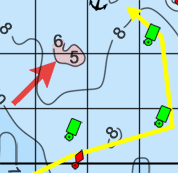 |
Snippet from Anegada Approach Chart showing shallow area near the entrance. |
Take serious note: There is a shallow area at N18° 43.20' W64° 23.25 that is not shown on any other chart, and is within the charted entrance channel on most other charts. At low tide, there may less than four feet of water over this spot!
Note: If you have CYC, Maptech, or C-MAP charts (paper or electronic), be aware that the Anegada entrance channel as charted on these charts is incorrect. The channel shown on those charts is the entrance channel prior to 1992. In 1992, new channel markers were placed and the channel was set slightly farther to the southeast. Click here for a snippet from the CYC/Maptech/C-MAP chart showing the correct Anegada entrance channel. The position of the green inner buoy (northernmost green buoy) as charted on the CYC chart is actually at the shallow area noted above!
Note: If you have Garmin BlueChart electronic charts, be aware that the Anegada entrance channel as charted on the Garmin BlueCharts is incorrect. That segment of the BlueChart is derived from British Admiralty chart #2008, which is out of date for its survey of the Anegada entrance channel. Click here for a snippet from the Garmin BlueChart showing the correct Anegada entrance channel. The position of the green inner buoy (northernmost green buoy) as charted on the v6 BlueChart is actually at the shallow area noted above!
IMPORTANT WARNING! Do not get too far to the west or southwest of the mooring balls in the Anegada Reef Hotel anchorage, as the water gets shallow with a muddy bottom there. (This is the shallow spot mentioned above, at approximately N18° 43.20' W64° 23.25). Groundings of boats with drafts of five feet or more are a common occurrence in this spot, and a large percentage of the groundings require assistance from a local fisherman's power boat. If you go aground in a monohull, remember that your boat most likely has a winged keel, and that heeling the boat will not free it because heeling increases the draft.
Anchor or moor as you prefer. Although it is grassy here, the bottom is soft mud and the holding is very good. We have sat off the hotel with a single anchor set in sustained winds of over 60 knots without dragging.
You will be in 6 to 8 feet of water, so 5 to 1 scope means that if you anchor, you only need to drop back about a boatlength after lowering the hook.
There is a marked channel off of the moorings leading to the west into an anchorage off of Neptune's Treasure. Do not anchor in this channel.
The GPS
coordinates for the buoys marking the channel to Neptune's Treasure are:
|
If you draw over 6 feet, you may want to anchor in deeper water. The deepest spot at Setting Point is to the east of the green inner buoy, and south of the government dock at position N18 43.050 W64 22.870. This spot is over 10 feet deep, and there is eight feet or more of water from the inner green buoy to this location. However, there is a "bump" with just under 8 feet depth just to the west of the green buoy, roughly half way between the position of the inner red buoy and the green buoy. You can safely avoid this spot by leaving the innermost red buoy to port by a boatlength or so when entering the anchorage. Having a copy of our Anegada approach chart will make it easy for you to locate a safe spot to anchor.
There is more than enough room, so be mindful of others and don't wind up directly over someone else's anchor. This has happened to us on more than one occasion. A very large crewed charter catamaran recently sat right off our bow, less than a boatlength in front of us. This is needless as well as aggravating.
You are there! Dinghy in to the Anegada Reef Hotel dock, get a famous "Smoodie", and put in your order for dinner. Then take a taxi over to Cow Wreck Beach or Loblolly Bay for Caribs, lunch, and limin'. Above all, don't get in a hurry -- you are really on island time now. If you go to Cow Wreck, chances are pretty good that you will find Walker limin', fishing, or bartending.
The "Lit' Bit Taz" Cash & Carry across the street from the hotel gate has a selection of most of the supplies that you might need to replenish your stock -- like drinking water, beer and liquor.
Fishing! If you are a fisherman, you will find spectacular fishing on Anegada. Bonefish, tarpon, permit, grouper, snapper, yellowtail, shark, barracuda - you name it, it is here, and can easily be caught from the beach or wading with light tackle. All you need is a spinning rod with a silver spoon and you are in business. If you are a serious fly-fisherman, book a bonefishing trip with renowned bonefish guides Danny Vaterpool, Garfield Faulkner, or Kevin Faulkner.
More tips from Walker: Be sure that you have a pair of polarized sunglasses! You have not seen the beauty of Anegada's miles and miles of beaches and reefs until you have seen them with good polarized sunglasses.
Walk out the hotel gate and a few steps up the road to the Lil Bit Taz cash & carry store just across from the Anegada Reef Hotel gate to restock whatever food and drink items you have depleted. Lil Bit also sells ice in large bags.
Just before you reenter the Anegada Reef Hotel gate, stop in V&J's Pottery Shop in the small building just to the left before the gate abd pick up a nice remembrance of Anegada.
You want to eat ashore at Anegada, and if you are only eating ashore one night, then you want to have lobster. The lobster dinner at the Potter's By the Sea, The Lobster Trap, the Wonky Dog, or the Anegada Reef Hotel are truly a one-of-a-kind thing, and will be one of the high points of your trip. The other meals are also fantastic, but the lobster is something special. After all, you have come all the way to Anegada -- a lobster dinner makes the trip complete.
If you are going to be on Anegada for a couple of days, rent a vehicle and explore. There really is a lot to see on Anegada. We recommend DW Jeep Rentals at 284-499-8765, L&M Rentals at 284-441-0563..
We have a large collection of aerial photographs that we have taken over the years of Anegada. Click here to see them.
This is a piece of Walker's artwork, titled "First Glimpse". It is a section of a photograph of Setting Point that we took in November of 2005 while traveling to Anegada on a remarkably clear and calm day. The photo was taken from the upper deck of a ferry from about 12 miles out with a very long image-stabilized telephoto lens. Sailboats in the anchorage are "hull down", with only the tops of their masts visible above the horizon. The buildings ashore are below the horizon.The distortion from the water vapor on the surface between us and Anegada gives the photo a watercolor painting effect.
1831 Chart of Anegada
(click for larger image)
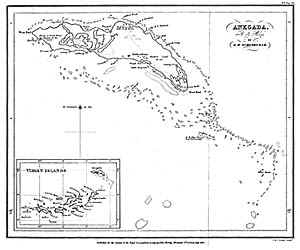
Is a sail to Anegada for only a one-night stay worth it? For most people Anegada is infectious, I think -- or at least habit-forming. The more of it that you get, the more that you need. One thing is for sure: it is a place quite different from the rest of the BVI and you either "get it" or you don't. There does not seem to be any half-way on this. I started out with a one-nighter there in 1987. But, luckily, I met Lowell Wheatley on that first night, and meeting him hooked me on Anegada. The next trip, we stayed a couple of nights. On subsequent trips, we found ourselves staying longer and longer. From the moment we got on the boat on the first day of a charter, all we could think about was getting to Anegada. When we left Anegada, all we did was wonder why we left and think about when we would go back there. In 2002, we anchored at Anegada for eight days out of a two-week charter. The boat didn't move at all, which prompted Captain Mike Kneafsey to dub our boat "the most expensive hotel room in the islands". We got Mike's point -- began sailing to Anegada for only a couple of nights, then returning and staying ashore. Or, even doing without the boat altogether. We made numerous trips to Anegada by air or by ferry, staying ashore. In 2007, Anegada became our home - we built a cottage that we call "Hidden Treasure" at Cow Wreck Beach. We now live on the island full time, returning to the US twice a year for a few weeks to do doctor stuff. So -- is a sail to Anegada for only a one-night stay worth it? It depends on you and your crew. Many people "get it" on a one-night stay, and you can, too. But, to "get it", you have to get away from the boat. Although it is a fun sail over, Anegada is not about boats and sailing. It's about the island itself and it's people. Anegada is the Hidden Treasure of the British Virgin Islands. It is easy to sail over and be there early in the day. Sailing to Anegada from either the North Sound or Marina Cay usually takes no longer than sailing to Cooper Island from the west end of Tortola, and is almost always a quicker sail than from Road Harbor to the North Sound. So, get up at sunrise and head for Anegada. When you get there, rent a car or take a taxi. I advise calling ahead to DW Jeep Rentals (284-495-9677) and reserving a rental vehicle, as the demand far exceeds the supply on Anegada. Leaving the Anegada Reef Hotel, head west from the anchorage and drop by Pomato Point, which is unbelievable in the morning. Then over to Ann's Tipsy at Cow Wreck Beach, where our personal "cheeseburger in paradise" really is. It's a funny thing -- we maybe have two burgers a year at home, but we have them every day at Tipsy. Along with Ann's conch fritters. And her ceviche. And a lobster or shellfish sandwich. Tipsy is the place to lime. In the afternoon, drop by Loblolly Bay -- usually a lot more people, and a different perspective. Hit the ARH bar before dinner. It is the early evening gathering place. Have dinner ashore. Any place within dinghy distance of the anchorage or walking distance of the ARH bar is good. After dinner, do the Setting Point beach bar crawl. We usually wind up at Potter's By The Sea. In the morning, check out Flash of Beauty (Loblolly East). It has the very best snorkeling on the island, and lunch there is superb. Monica is the West Indian food queen on Anegada. Get away by 2PM and you can be back at the North Sound, Trellis Bay, or Marina Cay by 5PM -- even if there is no wind. All you did was sandwich a trip to Anegada in between the trip from North Sound to Trellis Bay. You bet it was worth it! |
| Important Notice to Garmin BlueChart Users! Garmin BlueCharts include Russian chart Ru21085. Also, if you are using Garmin BlueChart version 6 or later, the charts include Don Street's Imray chart series. The charting of the Anegada area on some of these charts is incorrect by a substantial amount. Specifically, Russian chart Ru21085 and Imray charts Im1(a), Ima, Ima1(A), Ima2(A), and Ima23(A) are incorrect. All of these charts have the geographic features in the Anegada area approximately 1 mile to the northeast of their correct positions. When your GPS is zoomed to certain ranges, these charts may be selected for the display. If so, be aware that depth and geographic features relative to your position and waypoints will be shown incorrectly! Because of this, I strongly suggest that you disable these charts when in the Anegada area. When the charts are disabled, your GPS will simply select another of its charts that covers the area for that zoom range, and the depth and geographic features shown will be correct. The method for disabling individual charts varies from one Garmin GPS to another, but in general, it works like this: If you cannot disable these charts, then I suggest that you not download them at all to your GPS. |
NOTICE THE INFORMATION AND DATA ON THIS PAGE ARE PRESENTED FOR SUPPLEMENTARY REFERENCE ONLY, AND ARE NOT INTENDED AS A MEANS OF OR SUBSTITUTE FOR PROPER NAVIGATION AIDS. UNCHARTED AND UNMARKED HAZARDS EXIST. USE AT YOUR OWN RISK. DO NOT ATTEMPT PASSAGE TO ANEGADA WITHOUT APPROPRIATE CHARTS, BRIEFINGS, AND OTHER APPLICABLE INFORMATION. THE AUTHOR MAKES NO WARRANTY, EXPRESS OR IMPLIED, AS TO THE ACCURACY OR COMPLETENESS OF THE INFORMATION CONTAINED HEREIN. |
This page and the
contents thereof are the property of Walker Mangum
Copyright © 2002, 2007 by Walker Mangum
All rights reserved
Images on this page may not be reproduced without the express consent of Walker Mangum
You are welcome to create links to this page.
